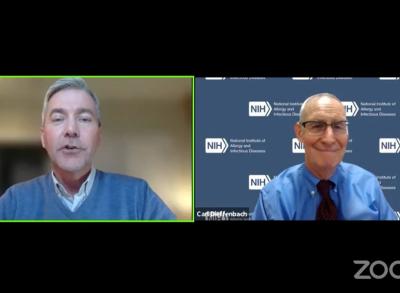(Cross-posted from HIV.gov)
In an HIV.gov video conversation on February 16, NIH’s Dr. Carl Dieffenbach discussed some of the pivotal HIV research advances presented this week at the 2022 virtual Conference on Retroviruses and Opportunistic Infections (CROI 2022). Dr. Dieffenbach, Director of the Division of AIDS at NIH’s National Institute of Allergy and Infectious Diseases (NIAID), covered developments in HIV cure research, HIV treatment and HIV prevention. Watch the conversation with Dr. Dieffenbach:
Here are some highlights from Dr. Dieffenbach’s conversation with HIV.gov:
HIV Cure Research
Dr. Dieffenbach first discussed a person whose HIV is in remission as the result of a stem cell transplant with an HIV-resistant mutation. The case was presented at CROI by Dr. Yvonne Bryson of the University of California, Los Angeles. This is only the third such case of HIV remission and the first in a woman and a person of mixed-race ancestry. The woman was diagnosed with leukemia after having been on treatment for HIV for several years. When she needed a stem cell transplant to treat the cancer, doctors used a combination of cord blood with the HIV-resistant mutation and stem cells from a close relative. About 37 months after the transplant, the woman stopped taking antiretroviral therapy (ART). No HIV has been detected in the woman for 14 months since cessation of ART. Dr. Dieffenbach reflected on the importance of this case, what it might mean for the future, and when and why the terms remission and cure are used. Read the NIAID news release about this study. Read the study abstract on the CROI website.
Very Early Treatment in Infants and the Promise of HIV Remission
Another study Dr. Dieffenbach discussed explored the effects of early intensive ART on achieving HIV remission in infants. The study, presented by Dr. Deborah Persaud of Johns Hopkins University, is following two small cohorts of children who acquired HIV in the womb and began receiving ART within 48 hours of birth. She presented virologic outcomes indicating that most the infants had achieved viral suppression, defined as HIV RNA less than 200 copies/mL, at six months of age. She also presented data on the amount of HIV DNA detected in the children’s cells, which reflected the size of their viral reservoir. Most of the children had no HIV DNA at two years of age. Having a smaller reservoir may make it possible for these children to stop taking ART and still maintain viral suppression. To evaluate this, in the next stage of the study, children who meet strict criteria will stop taking ART and have their HIV RNA levels closely monitored. Dr. Dieffenbach shared why that’s important and why he thinks pediatric studies are critical for HIV cure research. Read the study abstract on the CROI website. View more information on the study on the IMPAACT Network website.
Antibodies: A Possible Treatment Option for Very Young Children with HIV
Reflecting on future directions in HIV treatment, Dr. Dieffenbach discussed a proof-of-concept study on using broadly neutralizing antibodies (bNAbs) to treat HIV in children in Botswana. These powerful anti-HIV antibodies can stop a wide variety of HIV strains from infecting human cells in the laboratory. In the study, presented by Dr. Roger Shapiro of the Harvard T.H. Chan School of Public Health, 25 children with HIV between ages 2 and 5 years who had begun ART less than 7 days after birth and had undetectable viral loads were given monthly infusions of two bNAbs. The bNAbs were delivered first in combination with ART, and then later, if the children’s HIV remained undetectable, without ART. Eleven (44%) of the children maintained viral suppression through 24 weeks of bNAb-only treatment, and 14 (56%) had viral rebound before 24 weeks. The infusions were safe and well-tolerated. As Dr. Dieffenbach explained, parents found the bNAb infusions acceptable, with many preferring them to daily ART. He also discussed why he thinks bNAbs will be an important tool in future HIV treatment, prevention, and cure research. View the abstract on the CROI website.
Additional Data on Long-acting, Injectable Cabotegravir for PrEP
Finally, Dr. Dieffenbach highlighted a study providing additional data about long-acting injectable cabotegravir PrEP. Dr. Raphael Landovitz of the University of California Los Angeles reported data from one year of unblinded follow-up in the HIV Prevention Trials Network (HPTN) Study 083 among cisgender men and transgender women who have sex with men. This Phase 2b/3 randomized controlled trial previously demonstrated that a long-acting form of the HIV drug cabotegravir (CAB-LA) injected once every 8 weeks was more effective than daily oral Truvada at preventing HIV acquisition in the study population. At CROI, Dr. Landovitz reported that during the unblinded phase of the trial, the reduction in the risk of HIV acquisition from taking CAB-LA versus daily oral Truvada remained the same as during the blinded phase. Dr. Dieffenbach observed that scaling up available forms of PrEP and other HIV prevention tools will be key factors in achieving the goals of the National HIV/AIDS Strategy and the Ending the HIV Epidemic in the U.S. initiative. View the study abstract on the CROI website.
About CROI
CROI is an annual scientific meeting that brings together top researchers from around the world to present and discuss the latest studies that can help accelerate global progress in the response to HIV/AIDS and other infectious diseases, including COVID-19. More than 3,000 HIV and infectious disease researchers are gathering virtually this year over two weeks for this forum for translating laboratory and clinical research into progress against these diseases. Among the studies being presented are many that have been conducted or supported by NIH and CDC.
Join us again for another conversation with Dr. Dieffenbach at the conclusion of CROI 2022 next Thursday, February 24, 2022, at 5:15 PM (ET).



